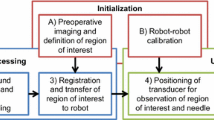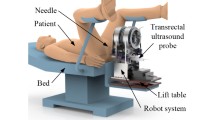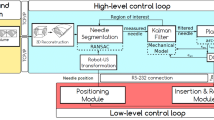Abstract
This paper describes a framework of algorithms for the active localization and tracking of flexible needles and targets during image-guided percutaneous interventions. The needle and target configurations are tracked by Bayesian filters employing models of the needle and target motions and measurements of the current system state obtained from an intra-operative imaging system which is controlled by an entropy-minimizing active localization algorithm. Versions of the system were built using particle and unscented Kalman filters and their performance was measured using both simulations and hardware experiments with real magnetic resonance imaging data of needle insertions into gel phantoms. Performance of the localization algorithms is given in terms of accuracy of the predictions and computational efficiency is discussed.









Similar content being viewed by others
Notes
This choice of image plane configurations is not fundamental to the proposed method. Arbitrary image plane configurations can be used without any modification to the algorithm.
The simulation studies reported in this section, and the experiments using real magnetic-resonance imaging data reported in Sect. 5 employed the same algorithms and models, except for image processing. Specifically, no image processing was performed in simulation studies, as the simulation directly generated the output of the image processing algorithm; whereas, the experiments with real imaging data employed the image processing algorithms presented in Sect. 3.
References
Abolhassani, Niki, Patel, Rajni, & Moallem, Mehrdad. (2007). Needle insertion into soft tissue: A survey. Medical Engineering & Physics, 29(4), 413–431.
Akashi, H., & Kumamoto, H. (1975). Construction of discrete-time nonlinear filter by monte carlo methods with variance-reducing techniques. Systems and Control, 19(4), 211–221.
Asadian, Ali, Kermani, Mehrdad R., & Patel, Rajni V. (2012). A novel force modeling scheme for needle insertion using multiple kalman filters. IEEE Transactions on Instrumentation and Measurement, 61(2), 429–438.
Brij Koolwal, A., Barbagli, F., Carlson, C., & Liang, D. (2010). An ultrasound-based localization algorithm for catheter ablation guidance in the left atrium. The International Journal of Robotics Research, 29(6), 643–665.
Burgard, W., Fox, D., & Thrun, S. (1997). Active mobile robot localization. In IJCAI (pp. 1346–1352).
Chatelain, P., Krupa, A., & Marchal, M. (2013). Real-time needle detection and tracking using a visually servoed 3d ultrasound probe. In 2013 IEEE International Conference on Robotics and Automation (ICRA) (pp. 1676–1681). IEEE.
Chen, Zhe. (2003). Bayesian filtering: From kalman filters to particle filters, and beyond. Statistics, 182(1), 1–69.
Cleary, K., Zhang, H., Glossop, N., Levy, E., Wood, B., & Banovac, F. (2005) Electromagnetic tracking for image-guided abdominal procedures: Overall system and technical issues. In 27th Annual International Conference of the Engineering in Medicine and Biology Society, 2005. IEEE-EMBS 2005 (pp. 6748–6753). IEEE.
Crouch, J. R., Schneider, C. M., Wainer, J., & Okamura, A. M. (2005). A velocity-dependent model for needle insertion in soft tissue. In Medical Image Computing and Computer-Assisted Intervention–Miccai 2005 (pp. 624–632). Springer.
DiMaio, S. P. (2003). Modelling, simulation and planning of needle motion in soft tissue. Ph.D.: University of British Columbia, Vancouver, Canada.
DiMaio, S. P., & Salcudean, S. E. (2003). Needle insertion modeling and simulation. IEEE Transactions on Robotics and Automation, 19(5), 864–875.
DiMaio, S. P., & Salcudean, S. E. (2005). Needle steering and motion planning in soft tissues. IEEE Transactions on Biomedical Engineering, 52(6), 965–974.
Dong, B., Savitsky, E., & Osher, S. (2009). A novel method for enhanced needle localization using ultrasound-guidance. Advances in Visual Computing, vol. 5875 of Lecture Notes in Computer Science (pp. 914–923). Berlin/Heidelberg: Springer.
Duda, R. O., Hart, P. E., et al. (1973). Pattern classification and scene analysis (Vol. 3). New York: Wiley.
Glozman, D., & Shoham, M. (2007). Image-guided robotic flexible needle steering. IEEE Transactions on Robotics, 23(3), 459–467.
Greer, J. D., Adebar, T. K., Hwang, G. L., & Okamura, A. M. (2014). Real-time 3d curved needle segmentation using combined b-mode and power doppler ultrasound. In Medical Image Computing and Computer-Assisted Intervention–MICCAI (pp. 381–388). Springer.
Kalman, R. E. (1960). A new approach to linear filtering and prediction problems. Journal of Fluids Engineering, 82(1), 35–45.
Kaya, M., & Bebek, O. (2014a). Gabor filter based localization of needles in ultrasound guided robotic interventions. In 2014 IEEE International Conference on Imaging Systems and Techniques (IST) (pp. 112–117). IEEE.
Kaya, M., & Bebek, O. (2014b). Needle localization using gabor filtering in 2d ultrasound images. In 2014 IEEE International Conference on Robotics and Automation (ICRA) (pp. 4881–4886). IEEE.
Khadem, M., Rossa, C., Usmani, N., Sloboda, R. S., & Tavakoli, M. (2016). A two-body rigid/flexible model of needle steering dynamics in soft tissue. IEEE/ASME Transactions on Mechatronics, 21(5), 2352–2364.
Maghsoudi, A., & Jahed, M. (2012). Needle dynamics modelling and control in prostate brachytherapy. IET Control Theory Applications, 6(11), 1671–1681.
Misra, S., Reed, K. B., Schafer, B. W. , Ramesh, K. T., & Okamura, A. M. (2009). Observations and models for needle-tissue interactions. In IEEE International Conference on Robotics and Automation, 2009. ICRA ’09, pp. 2687–2692.
Neubach, Z., & Shoham, M. (2010). Ultrasound-guided robot for flexible needle steering. IEEE Transactions on Biomedical Engineering, 57(4), 799–805.
Okazawa, A. M., Simone, C., & O’Leary, M. D. (2004). Force modeling for needle insertion into soft tissue. IEEE Transactions on Biomedical Engineering, 51(10), 1707–1716.
Okazawa, S. H., Ebrahimi, R., Chuang, J., Rohling, R. N., & Salcudean, S. E. (2006). Methods for segmenting curved needles in ultrasound images. Medical image analysis, 10(3), 330–342.
Orguner, U. (2008). Notes on differential entropy calculation using particles. Technical report, Department of Electrical Engineering, Linkping University.
Park, W., Kim, J. S., Zhou, Y., Cowan, N. J., Okamura, A. M., & Chirikjian, G. S. (2005). Diffusion-based motion planning for a nonholonomic flexible needle model. In Proceedings of the IEEE In’l Conference on Robotics and Automation, pp. 4600–4605.
Renfrew, M., Bai, Z., & Cavusoglu, M. C. (2013). Particle filter based active localization of target and needle in robotic image-guided intervention systems. In IEEE International Conference on Automation Science and Engineering (CASE) (pp. 448–454). IEEE.
Ryan, A., & Hedrick, J. K. (2010). Particle filter based information-theoretic active sensing. Robotics and Autonomous Systems, 58(5), 574–584.
Särkkä, S. (2013). Bayesian filtering and smoothing (Vol. 3). Cambridge, UK: Cambridge University Press.
Thrun, S., Burgard, W., & Fox, D. (2005). Probabilistic robotics. Cambridge, MA: MIT press.
Tully, S. T .(2012). BodySLAM: Localization and mapping for surgical guidance. Ph.D. thesis, Carnegie Mellon University.
Vrooijink, G. J., Abayazid, M., Patil, S., Alterovitz, R., & Misra, S. (2014). Needle path planning and steering in a three-dimensional non-static environment using two-dimensional ultrasound images. The International Journal of Robotics Research, 33(10), 1361–1374.
Wan, E. A. & Van Der Merwe, R. (2000). The unscented kalman filter for nonlinear estimation. In The IEEE 2000 Adaptive Systems for Signal Processing, Communications, and Control Symposium 2000. AS-SPCC (pp. 153–158). IEEE.
Webster III, R. J., Kim, J. S., Cowan, N. J., Chirikjian, G. S., & Okamura, A. M. (2006). Nonholonomic modeling of needle steering. International Journal of Robotics Research, 25(5–6), 509–525.
Wong, S. W., Niazi, A. U., Chin, K. J., & Chan, V. W. (2013). Real-time ultrasound-guided spinal anesthesia using the sonixgps® needle tracking system: A case report. Canadian Journal of Anesthesia/Journal canadien d’anesthésie, 60(1), 50–53.
Xie, Y., & Ji, Q. (2002). A new efficient ellipse detection method. In 16th International Conference on Pattern Recognition, 2002. Proceedings (vol. 2, pp. 957–960). IEEE.
Acknowledgements
This work was supported in part by the National Science Foundation under grants CISE CNS-1035602 and IIS-1563805, and the National Institutes of Health under grant R01 EB018108.
Author information
Authors and Affiliations
Corresponding author
Appendix
Appendix
This appendix presents the phases of needle motion in more detail. Needle motion consists of three phases: perturbation of the insertion point and propagation of the perturbation (Algorithm 7), axial insertion of the needle (Algorithm 8), and addition of random perturbations. Figure 10 shows an example of the axial insertion procedure.


Rights and permissions
About this article
Cite this article
Renfrew, M., Griswold, M. & Çavuşoĝlu, M.C. Active localization and tracking of needle and target in robotic image-guided intervention systems. Auton Robot 42, 83–97 (2018). https://doi.org/10.1007/s10514-017-9640-2
Received:
Accepted:
Published:
Issue Date:
DOI: https://doi.org/10.1007/s10514-017-9640-2





